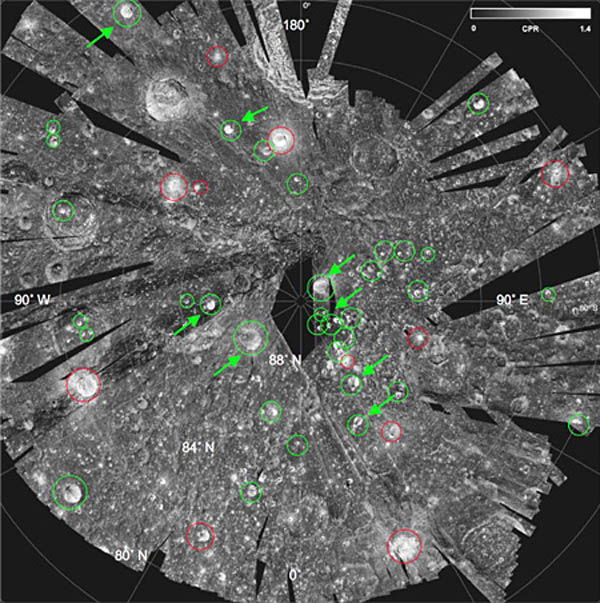March 2, 2010
More Than a Bucket Full

image from NASA Mini-RF webpage; red circled craters are normal fresh impacts and green ones are anomalous with characteristics of icy interiors.
The most important news to come from the first day of the Lunar & Planetary Science Conference in Houston Monday was not from a presentation in the scientific program but from a press release. Paul Spudis, principal investigator for the NASA-funded Min-SAR radar on India's Chandrayaan-1 spacecraft, reported that the team had identified more than 40 small craters around the lunar north pole that appear to contain ice. The radar transmits pulses of energy that are left-circular polarized and most of the returned signal from the lunar surface is oppositely polarized (and is gray on the mosaic above). The bright spots on the mosaic are where reflectance of left-circular energy occurs. From terrestrial experiments and theory, same sense reflectance - left transmitted and bounced back - is caused by fresh craters with many angular boulders, and by multiple reflections within ice at least a meter thick. To distinguish which of the bright craters in the mosaic are boulder-rich and which possibly have ice on their floors, the Mini-SAR team looked to see which craters had brightness outside the rim - where boulders would be common on fresh craters - as well as on the interior. The craters that have brightness only on the interior probably aren't fresh boulder-rich craters, and are considered most likely to have ice on their interiors. Notice that some of the nominal icy craters are as far as 10° away from the pole. Presumably only small craters with steep walls would be in perpetual darkness, accounting for the discoveries of ice in small craters (2-15 km diameters) and not big ones. Estimates of ice amounts are uncertain but are huge: hundreds of millions of tons. Congratulations to Paul and the Mini-SAR team!
Chuck Wood
Yesterday's LPOD: Not a Whiskey, Nor a Flask
Tomorrow's LPOD: Uncovering Lava Flows
COMMENTS?
Register, Log in, and join in the comments.



